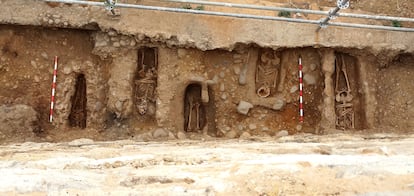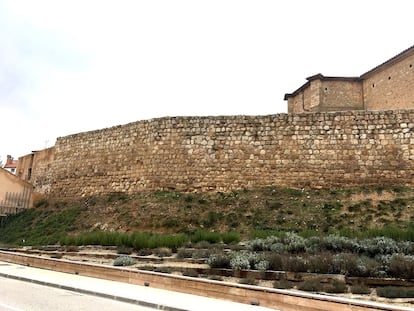Medieval Spain: the tale of a missing stone and 11 bodies under a wall
Archeologists digging in a village that was once a center of power find corpses in an unusual location


Almazán is a small town in Spain’s Soria province, on the banks of the River Duero. Its population is just under 5,500 but in the Middle Ages it was a powerful political hub where the kings of Castile and Navarre met to coordinate incursions into Muslim territory.
Over the centuries, it undoubtedly saw major historical figures pass through its gates, such as Doña Urraca, Alfonso VI, Sancho III of Castile, Alfonso I of Aragón, Alfonso I “The Battler,” and Alfonso VII “The Emperor.”
The town was well protected by a defensive wall and a moat, thought to have been built around 1128, although there is no hard evidence to support this. Now, the recent study Almazán: its necropolis and medieval walls, written by experts from Madrid’s Complutense and Autonomous Universities and the Baraka archaeological team, has uncovered a dark secret that was hiding under the bastion.
After conducting 15 archeological surveys and subsequently excavating the entire area, the remains of 22 bodies have been discovered, 11 of which were literally buried under the stone wall. And the researchers have not ruled out the existence of other corpses in the vicinity.

But this is not the only mystery brought to light by the investigation: a medieval inscription carved on stone was sent to Madrid for safekeeping at the end of the 19th century, but inexplicably went missing. As a result, researchers do not know for a fact which king was responsible for building the wall.
The study, written by the archaeologists and biologists Manuel Retuerce Velasco, Luis Alejandro García García, Jesús Herrerín López and Ainara Acebo Pérez, attempts to shed light on the odd location of the graves. Researchers point out that in the 12th century, the church of Santa María de Calatañazor was built near the eastern wall, and that the remains could belong to the church’s cemetery, as the church itself was replaced in the 16th century by the one currently occupying the site.
The authors of the study believe there are three possible explanations for the treatment of the bodies, which have been challenging to reach. “The excavation turned out to be quite difficult due to the state in which they [the corpses] were found – very fragile, fragmented and not very consistent,” says Manuel Retuerce, who teaches archeology at Madrid’s Complutense University. The remains that they managed to remove were transported to a laboratory, while those located directly under the wall and whose tombs extended into the inside of the walled perimeter were left where they were.
The researchers believe that before these graves were covered by the wall, they were in all likelihood visible on the surface, though this appears to have posed no obstacle to the building plans. And while the most logical hypothesis, according to Retuerce, is that the tombs belonged to Christians, the fact they are staggered and covered with wood does not completely rule out that the dead were Jewish or Muslim. Wood was a common material in medieval times for all three religions. In Christian and Hebrew cemeteries, the coffin lids were made of wood and, with regard to Muslim burials, a grave dug out in the earth could also be covered with wooden planks known as alwah.
Although archaeologists are more inclined to believe these were Christian tombs, Retuerce points out that if it were a Jewish necropolis, it would more easily explain why the city wall was built over it, as any opposition from this religious minority “could be more easily disregarded than if the necropolis had been Christian.”
The missing inscription
Having also analyzed the construction of the wall itself, the study reveals another curious fact about the town’s Market Gate. In the 19th century, this gateway into town still bore an inscription on the keystone of the inner arch referring to a king named Alfonso. This stone was removed and deposited at the Royal Academy of History in 1896. These days, however, there appears to be no trace of it at the institution.
The Royal Academy of History has told EL PAÍS that it does not know where this item might be located, but that it is definitely not in the academy’s storage or in the National Archaeology Museum. A letter that is kept in the academy’s archives, dated March 2, 1896, and signed by the academic Elias Romera, certifies that the stone was indeed given to the institution, and that it “supposedly” dates back to the reign of Alfonso VI, although it also mentions Alfonso I The Battler, Doña Urraca and Alfonso VII. “It is unbelievable how such an inscription could have disappeared from an institution like this one,” says a spokesman.
Unfortunately, the stone’s mysterious disappearance makes it impossible to determine which king’s name was on the inscription, and consequently to establish more details about the history of the town and its wall; possible candidates include Alfonso VI of Castile and León, Alfonso I of Aragón, Alfonso VII of León and Castile, Alfonso VIII of Castile and even Alfonso X of Castile and León. All of them had some connection to this town in Soria and its mysterious 12th-century wall where at least 11 bodies will be left to rest in peace.
English version by Heather Galloway.
Tu suscripción se está usando en otro dispositivo
¿Quieres añadir otro usuario a tu suscripción?
Si continúas leyendo en este dispositivo, no se podrá leer en el otro.
FlechaTu suscripción se está usando en otro dispositivo y solo puedes acceder a EL PAÍS desde un dispositivo a la vez.
Si quieres compartir tu cuenta, cambia tu suscripción a la modalidad Premium, así podrás añadir otro usuario. Cada uno accederá con su propia cuenta de email, lo que os permitirá personalizar vuestra experiencia en EL PAÍS.
¿Tienes una suscripción de empresa? Accede aquí para contratar más cuentas.
En el caso de no saber quién está usando tu cuenta, te recomendamos cambiar tu contraseña aquí.
Si decides continuar compartiendo tu cuenta, este mensaje se mostrará en tu dispositivo y en el de la otra persona que está usando tu cuenta de forma indefinida, afectando a tu experiencia de lectura. Puedes consultar aquí los términos y condiciones de la suscripción digital.
More information
Últimas noticias
The metaverse, four years later: Is it finished or just at a standstill?
$3,000 and a plane ticket: The United States increases incentives for migrants to self-deport before the end of the year
Charles Dubouloz, mountaineering star, retires at 36 with a farewell tour inspired by Walter Bonatti
From the White House to diplomatic gifts: Lego wins over adult fans, brick by brick
Most viewed
- Families demand repatriation of bodies of Colombians who died in Ukraine: ‘This war is a slaughterhouse for foreigners’
- The low-cost creative revolution: How technology is making art accessible to everyone
- Liset Menéndez de la Prida, neuroscientist: ‘It’s not normal to constantly seek pleasure; it’s important to be bored, to be calm’
- Christian Louboutin: ‘Young people don’t want to be like their parents. And if their parents wear sneakers, they’re going to look for something else’
- Christmas loses its festive spirit: ICE fears cast shadow over religious celebrations










































